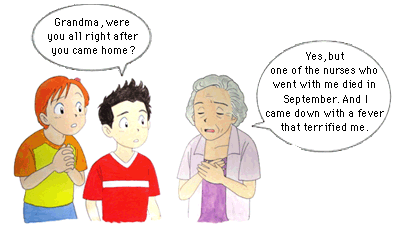
 |
 |
| 59 Looking for missing relatives August 12, 1945 / Ujina-machi (3,900m from the hypocenter) People visited relief stations looking for missing family members and friends. The relief stations made lists of the patients and attached tags to those identified stating name and address. However, many died and were cremated without ever being identified. Their ashes and belongings were never returned to their families. |
60 Medicines form overseas Desperately needed medical supplies for relief stations came not only from other areas of Japan but also from other countries. When he learned of the tragic conditions in Hiroshima and the need for relief supplies, Dr. Marcel Junod, chief representative of the International Committee of the Red Cross Delegation in Japan, negotiated with the General Headquarters of the Allied Powers. Receiving enough supplies and medicines to treat 10,000 patients for one month, he came toHiroshima on September 8 and presented about 15 tons of supplies to the governor of Hiroshima Prefecture. |
 |
61 Cremation certificate This is the cremation certificate for the corpse of a patient who died at a relief station. It gives the person's name, official residence, place of death, cause of death, and other information. |
 |
62 War Casualty Inquest Ledger (Kaitaichi Police Station) Despite attentive care, many of the patients at relief stations died. This War Casualty Inquest Ledger notes the cause and date of death for the persons that died at the relief station. With notations like "Burns" or "Burned to death" the records convey all too vividly the conditions prevailing at the time of the bombing. |
 |
 |
| 63 Acute effects August 28, 1945 Damage to human bodies from the atomic bombing was not limited to burns and lacerations. Other symptoms included fatigue, high fever, diarrhea, hair loss, and pupura (purple spots from bleeding under the skin). Appearing during the short period from the bombing to the end of that year, such symptoms were termed acute effects. Radiation effects often appeared in people with no other injury and those who entered the city only after the bombing. Many such victims died. |
64 A soldier with pupura on his face September 3, 1945 / Exposed in a wooden building 1,000m from the hypocenter Ujina Branch of Hiroshima First Army Hospital A characteristic acute effect was pupura. Because most who developed them died, they were feared as the "spots of death." The soldier in the photo died five days after the spots appeared. |
 |
65 Ignorant of radiation effects August 9, 1945 / kamiya-cho (300m from the hypocenter) Acute effects were seen not only in people who experienced the atomic bombing, but also among those who entered the city shortly thereafter. For a number of days, radiation in the city remained at harmful levels. Many persons who participated in relief activities developed symptoms after they returned home. |

| 66 Folk remedies Many victims suffering acute effects were unable to get proper medicine and treatment or enough food. In desperation, people tried a variety of folk remedies, having no idea what might be effective. One of those methods was moxibustion. |
| 67 Analysis of A-bomb symptoms Immediately after the bombing, military and university investigative teams arrived in Hiroshima to study the A-bomb damage. Doctor Masao Tsuzuki of Tokyo Imperial University (now, Tokyo University) described the relation between distance from hypocenter and gravity of injury. Based on a detailed study of symptoms, the team advised survivors to get sufficient rest and supplement their diets with vitamins and other nutrients. |
| 68 Closing the relief stations As stipulated by the Wartime Casualties Care Law, the rescue and relief activities that began immediately after the bombing continued for two months. Between August 11 and October 5, a total of 105,862 persons were taken in at relief stations and another 210,048 persons were treated as outpatients. When the relief stations closed, people had to pay for their own care. Those who could not pay for hospitalization were placed under the responsibility of their city, town, or village. Because the Fukuromachi Elementary School relief station was still serving so many survivors, it remained open even after October 5. That station was closed the following year when the school reopened. |
| 69 Continuing treatment of survivors November 13, 1945 In addition to the acute effects that appeared immediately after the bombing, radiation caused a variety of long-term health problems. Burn scars developed into keloids. Some years later, a high percentage of survivors came down with leukemia or other cancers. Because the effects of radiation remain obscure even today, survivors continually fear for their health. Continued research is necessary. |
 |
| Helping
Victims in the Burnt Plain -- Relief Activities with neither Medicine nor Food to Offer -- Preparing for Air Raids Relief Activities amid the Turmoil Full-scale Relief Activities Conditions in Relief Stations and the Suffering of the People(1) Conditions in Relief Stations and the Suffering of the People(2) Relief Activities by the Akatsuki Corps on August 6 Conclusion Individuals and Group Contributors to This Exhibition Return to TOP |